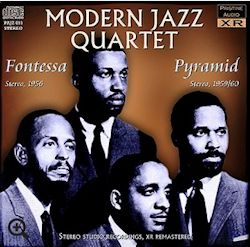Fontessa
1. Versailles (Port De Versailles)
2. Angel Eyes
3. Fontessa
4. Over The Rainbow
5. Bluesology
6. Willow Weep For Me
7. Woody’n You
Pyramid
1. Vendome
2. Pyramid (Blues For Junior)
3. It Don’t Mean A Thing
4. Django
5. How High The Moon
6. Romaine
John Lewis – Piano
Milt Jackson – Vibes
Percy Heath – Bass
Connie Kay – Drums
Fontessa
and Pyramid could be considered the final two chapters which, along with previously issued Concorde (not part of this collection)
represented the Modern Jazz Quartet’s fascination with all things Paris, and the musical inventiveness that this magical city engenders. It also marks a
beginning, as Fontessa was the MJQ’s first release on the Atlantic label; a relationship that was to extend for some 25 years.
At this point in their musical journey, the group had settled in with their new drummer Connie Kay (replacing Kenny Clarke) and had directionally moved
away from the more bop-influenced offerings, to longer-form story-telling compositions, that had a decidedly chamber-music feel. It’s not that the group
couldn’t swing, they did. But the swinging was more restrained and refined. The MJQ’s sound was unmistakable, with Milt Jackson’s vibes leading the way as
he played long-held notes full of reverb, coupled with ascending or descending triplets. John Lewis was the master of a singular single-note style that
swung with sparseness. The opening two tracks Versailles and Angel Eyes amply demonstrate these characteristics.
The keynote feature of this album was the long-form suite written by John Lewis called Fontessa which was based on the 17th-century
style of improvised plays called Commedia dell’Arte. After the soft-toned opening prologue, the piece segues into a sprightly romp with Lewis’s
piano in the lead supported by a bass/drum backdrop. A melodic turn is then offered with Lewis and Jackson exchanging themes. A murkier tone section
follows with Kay’s cymbals in sharp relief in this minimalist accompaniment. The final section restates the opening theme but in a more downhearted vein.
This evocative composition readily demonstrates the flexibility and versatility of the group. The remaining tunes on this album are a combination of two
popular standards and two jazz melodies each of which offers the band improvisational opportunities. On Milt Jackson’s Bluesology both Jackson and
Lewis take advantage of the composition’s blues structure to deliver inspired solos and a brilliant reading of the material. On the Arlen/Harburg standard Over The Rainbow drummer Connie Kay drops out, leaving Jackson and Lewis reliant on the bass of Percy Heath which gives the tune a meditative air.
By the time Pyramid was released in 1960, the MJQ had moved into celebrated status and the two distinguishing voices in the band, Jackson’s vibes
and Lewis’ piano, seemed to find common ground in the counterpoint arrangements that dominated their play-book. The Paris-inspired theme continues with the
opening track Vendome and it is easy to imagine the cars darting around the monument in the center of the Place, as Jackson and Lewis play off
each other in Bach-like fashion. The title track Pyramid (Blues For Junior) is the album’s signature track coming in at close to eleven minutes.
It starts off in a slow blues funeral-march tempo then segues into a more funky rhythm with Jackson’s vibes in the forefront. Lewis then picks up the line
with some of his signature single note ruminations. The composition moves forward with some text-book vibes/piano interplay with Kay’s drums in the
background and Heath’s warm–toned bass providing support.
In 1956, the MJQ released the album Django which contained this title-tune written by John Lewis to commemorate the great gypsy guitarist Django
Reinhardt. By 1960 it had become so associated with the band, they decided to reprise it, featuring Kay’s feather-touch brush work supporting the ever
imaginative Jackson’s evocative vibes. Lewis’s economical pianistic style gives It Don’t Mean A Thing and How High The Moon just the
right simplicity that the animated Jackson feeds off the riffs to spin out his solos with his usual seamlessness.
Finally a word about the recording. The producer Andrew Ross of Pristine Audio has delivered these albums, which are superior listening experiences in
every way to anything that has been done in the past with these two titles. If you like the MJQ, you’ll love them when you hear this release.
Pierre Giroux
